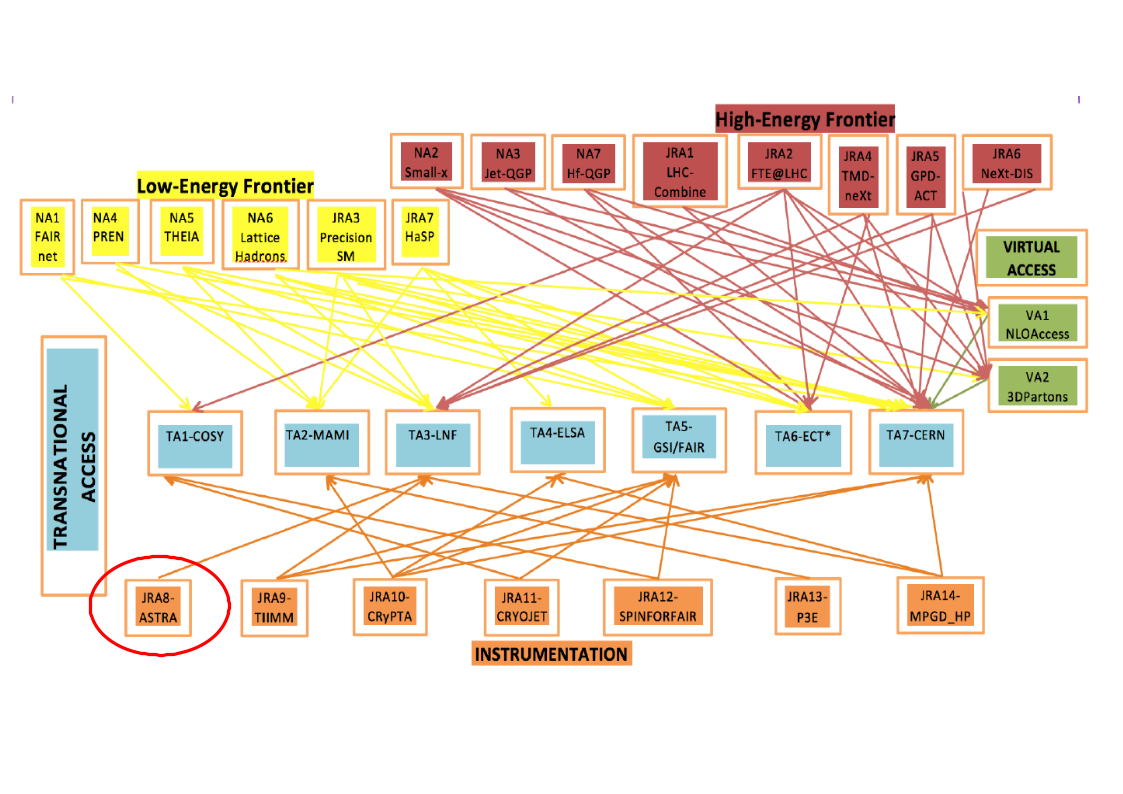Horizon 2020
STRONG-2020 - the new European project at the forefront of strong interaction studies

The theoretical and experimental studies of the strong interaction, a cornerstone of the Standard Model (SM) of particle physics, attract an active community of about 2500 researchers in Europe. The list of open questions at the frontier of our present knowledge in this field is rich, and include a full understanding of: the tri-dimensional structure of the proton; the spectroscopy of hadrons and their exotic states; the properties of the hot and dense quark-gluon plasma; precision studies of the SM. These research topics are experimentally studied mostly by particle collisions at low (GeV range) and high (up to 14 TeV) energies, which require continuous developments in state-of-the-art detectors, data acquisition systems, beams and targets, as well as in the underlying theory.
The STRONG-2020 project, a European Integrating Activity for Advanced Community, recently approved by the European Community within the Horizon-2020 – Research and Innovation Framework Programme, is a structured enterprise to address the open questions in the strong interaction studies in theory and experiment, building upon and going beyond the previous Hadron Physics HP, HP2 and HP3 projects in the framework programmes of FP6 and FP7.
STRONG-2020 brings together many of the European leading research groups and infrastructures presently involved in the forefront research in strong interaction. It provides transnational access to six world-class research infrastructures in Europe, which complement each other in particle beams characteristics (COSY, MAMI, LNF-INFN, ELSA, GSI, CERN) and virtual access to open-source codes and automated/simulation tools. STRONG-2020 fosters the synergy between theoreticians and experimentalists, supporting the activities of the European Centre for Theoretical Studies in Nuclear Physics and Related Areas (ECT*, Trento).
The STRONG-2020 Consortium includes 44 participant institutions, embracing 14 EU Member States, one International EU Interest Organization (CERN) and one EU candidate country (Montenegro). Together with host institutions of other 21 countries, participating in the activities without EU benefits, STRONG-2020 involves research in 36 countries. The project is structured in 32 Work Packages (WP): Project Management and Coordination, Dissemination and Communication, 7 Transnational Access Activities, 2 Virtual Access Activities, 7 Networking Activities and 14 Joint Research Activities.
The STRONG-2020 results will have a significant impact in the study of the strong interaction and the SM. The project will also contribute to fundamental research for physics beyond SM, impacting in other scientific sectors, such as astrophysics and theories of strongly coupled complex systems in condensed matter. The tools and methodologies for the new-cutting-edge experiments within STRONG-2020 will provide upgrades to the European Research Infrastructures, enhancing their competitiveness. The developed technologies will also impact in medicine (diagnostic tools, cancer treatment) and industry (line-scan cameras, 3D-magnets technology) and may also lead to advances in computing/machine learning.
STRONG-2020 will promote training and education activities, including students and postdocs, which will bring qualified personnel to the job market, as well as dissemination activities at current state of the art in science communication.
Partner Institutions
Lead partner institution
Stefan Meyer Institute for Subatomic Physics, OeAW, Vienna, AUSTRIA
Johann Zmeskal
Participant institutions
Istituto Materiali per Elettronica e Magnetismo, CNR, Parma, ITALY
Andrea Zappettini
Jagiellonian University, Krakow, POLAND
Pawel Moskal
Laboratori Nazionali di Frascati (LNF) – INFN, Frascati, ITALY
Alessandro Scordo
Politecnico Milano, Dipartimento di Elettronica, Milano, ITALY
Carlo Fiorini
University of Zagreb, Zagreb, CROATIA
Damir Bosnar
ASTRA research objectives
The main objective of the ASTRA project is to develop beyond state-of-art ultra-fast radiation detector systems for high-precision measurements of gamma- and X-ray events in a broad energy range, capable to operate in different environments. The development of advanced and high-performance radiation detector systems, in terms of time resolution, efficiency, stability, linearity, energy resolution, compactness and acceptance, is mandatory in hadron physics, and will allow to perform measurements never done before due to the lack of suitable detectors. These measurements will have a huge impact in our understanding of the fundamental laws of nature.
Cadmium telluride (CdTe) and cadmium zinc telluride (CdZnTe) are very promising semiconductor materials for X-ray and gamma ray detection. The high atomic numbers of the materials (ZCd=48, ZTe=52) provide a high quantum efficiency in comparison with Si. The larger band-gap energy (Eg∼1.5 eV, compared to Si Eg∼1.1 eV) allows the operation of the detector at room temperature. However, up to now, a considerable amount of charge loss in these detectors resulted in a reduced energy resolution. Recently, significant technological advancements have been achieved to improve the spectral properties and time resolution, based on the advances in the production of crystals and in the design of electrodes and digital readout electronics.
Within a broad international collaboration we will develop advanced CdZnTe detector systems, from sensors and readout electronics to DAQ, for high precision spectroscopic measurements of radiation in a high radiation environment in a wide energy range from a few ten keV to MeV. For the higher energy range up to MeV we will use CdZnTe, working at room temperature with the goal to achieve an energy resolution of 1 keV (FWHM) at 200 keV. For low (5-20 keV) and medium (20-5 keV) energy we will cool the device below -10°C trying to achieve an energy resolution better than 500 eV (FWHM) for lower energies and 700 eV (FWHM) for the medium energy range. The energy resolution is slight worse than achieved with Si-detectors or HPGe, but much better timing and high rate capability will be reached, as well as working conditions close to room temperature.